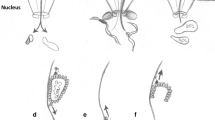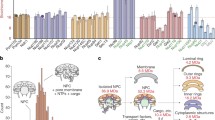Abstract
The nuclear pore complex (NPC) occupies a unique position in the architecture of the eucaryotic cell in that it forms the gateway between two environments, the nucleus and the cytoplasm, which are topologically equivalent but which differ in their macromolecular composition. Strictly speaking, the nucleus is not a membrane-bound organelle but rather can be thought of as an area of the cell surrounded by incompletely fused membrane vesicles with NPCs occupying the pores. Undoubtedly, one of the more fundamental functions of the NPC is simply to keep these pores open and to prevent the vesicles from fusing completely and isolating the nucleus from the cytoplasm. The existence of such pores in the nuclear envelope appears to be a simple way to allow the free passage of ions and small molecules between the nucleus and cytoplasm [14,15] without the necessity for a sophisticated system of channels which is required with a truly membrane bound organelle. Nevertheless, the NPC does carry out a barrier function since molecules larger than ~90A in diameter do not traverse it freely [14]. Large molecules are selectively imported into the nucleus and evidence is accumulating that such proteins contain a nuclear localization signal — a short sequence containing positively charged amino acid residues [3,5,10,16].
Access this chapter
Tax calculation will be finalised at checkout
Purchases are for personal use only
Preview
Unable to display preview. Download preview PDF.
Similar content being viewed by others
References
Clawson GA and Smuckler EA (1982) J Theor Biol 95: 607–613.
Crowther RA and Amos LA (1971) J Mol Biol 60: 123–130.
Davey J, Dimmock NJ and Colman A (1985) Cell 40: 667–675.
Dingwall C (1985) TIBS 10: 64–66.
Dingwall C, Sharnick SV and Laskey RA (1982) Cell 30: 449–458.
Feldherr CM, Kallenbach E and Schultz N (1984) J Cell Biol 99: 2216–2222.
Gerace L, Comeau C and Benson M (1984) J Cell Sci, Suppl 1: 137–160.
Gerace L, Ottaviano Y and Kondor-Koch C (1982) J Cell Biol 95: 826–837.
Harris, JR and Marshall P (1981) in Electron Microscopy of Proteins, Vol 1 ( New York: Academic Press ).
Kalderon D, Roberts BL, Richardson WD and Smith AE (1984) Cell 39: 499–509.
Kessel RG (1983) Int Rev Cytol 82: 181–303.
Krohne G, Debus E, Osborn M, Weber K and Franke WW (1984) Expl Cell Res 150: 47–59.
Melton DA, DeRobertis EM and Cortese R (1980) Nature 284: 143–148.
Paine PL, Moore LC and Horowitz SB (1975) Nature 254: 109–114.
Peters R (1984) EMBO J 3: 1831–1836.
Richardson WD, Roberts BL and Smith AE (1986) Cell 44: 77–85.
Saxton WO, Pitt TJ and Horner M (1979) Ultramicroscopy 4: 343–354.
Stafstrom JP and Staehelin LA (1984) J Cell Biol 98: 699–708.
Wickens MP and Gurdon JB (1983) J Mol Biol 163: 1–26.
Unwin PNT and Milligan RA (1982) J Cell Biol 93: 63–75.
Author information
Authors and Affiliations
Editor information
Editors and Affiliations
Rights and permissions
Copyright information
© 1986 Springer-Verlag, Berlin Heidelberg
About this paper
Cite this paper
Milligan, R.A. (1986). A Structural Model for the Nuclear Pore Complex. In: Peters, R., Trendelenburg, M. (eds) Nucleocytoplasmic Transport. Springer, Berlin, Heidelberg. https://doi.org/10.1007/978-3-642-71565-5_10
Download citation
DOI: https://doi.org/10.1007/978-3-642-71565-5_10
Publisher Name: Springer, Berlin, Heidelberg
Print ISBN: 978-3-642-71567-9
Online ISBN: 978-3-642-71565-5
eBook Packages: Springer Book Archive




